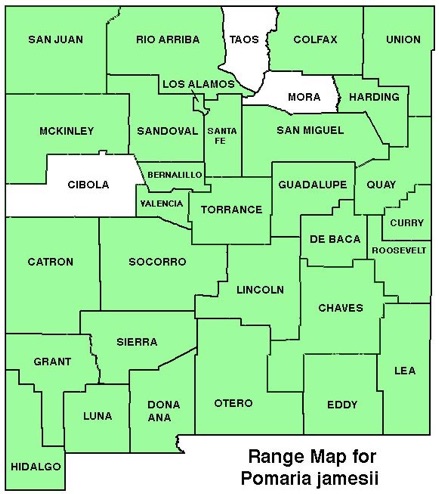WILDFLOWERS OF NEW MEXICO

These small, delicate, sprawling plants, dotted throughout with red-orange glands in tiny pits (not stalked glands), have small yellow pea-like flowers. Multiple slender stems reach 15 3/4-inches tall and are covered with tiny, flat-lying hairs. Note the stamens are contained within the petals, and the small compound leaflets have orange gland dots on the undersides.
FLOWER: May–September. Asymmetrical, 3/8-inch long flowers with 5, orange-yellow petals, usually with red basal markings, bloom on a spike from the bottom up. Stamens hang downward against the cupped lower petal but are shorter that the petal. Red-orange glands dot the stem and sepals enclosing the buds and the crescent-shaped, 1-inch long, 3/8-inch wide pod, which has 2 seeds.
LEAVES: Alternate. The twice-compound leaves are divided into 5–7 segments or ribs (pinnae), each with 5–10 pairs of 1/8–1/4-inch long leaflets with rows of red gland dots on the undersides.
HABITAT: Sandy, gravelly soils, roadsides, disturbed areas; desert grasslands and scrub, pinyon-juniper woodlands.
ELEVATION: 3,300–7,000 feet.
RANGE: AZ, CA, CO, KS, MO, NE, NM, OK, TX.
SIMILAR SPECIES: The look-alike Indian Rush-Pea or Hog Potato, Hoffmannseggia glauca, in much the same habitat and range, has stems covered with stalked, red-tipped glands, stamens longer than the petals, and leaflets without orange glands on the undersides.
NM COUNTIES: nearly statewide (not reported in Cibola, Mora, Taos, Union cos.) at low-to mid-elevation, dry habitats.

JAMES RUSH-PEA
POMARIA JAMESII (HOFFMANNSEGGIA JAMESII)
Legume Family, Fabaceae
Perennial herb

THE CONTENTS OF THIS WEBSITE ARE COPYRIGHTED AND CANNOT BE USED
WITHOUT PERMISSION OF GEORGE OXFORD MILLER


Stamens are held within the cupped lower petal.



Orange glands in tiny pits dot the stem, flowers, seeds, and undersides of the leaflets.




EMAIL ME